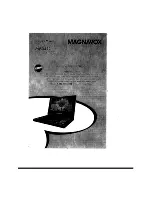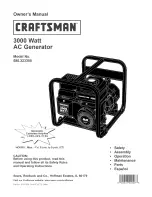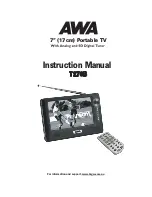
FMI=11—ROOT CAUSE NOT KNOWN
It has been detected that a failure has occurred in a particular subsystem but the exact nature of the fault is not known. Broadcast
of data value is substituted with the “error indicator” value.
FMI=12—BAD INTELLIGENT DEVICE OR COMPONENT
Internal diagnostic procedures have determined that the failure is one which requires the replacement of the ECU, used here to
mean the packaged unit that includes some microprocessor and its associated components and circuits. It can be assumed that the
communications subsystem is not the part that has failed, and the manufacturer has determined that there is no serviceable
component smaller than the ECU involved in the failure. Broadcast of data value is substituted with the “error indicator” value if
appropriate, as there may or may not be any broadcast involved. This error is to include all internal controller trouble codes that can
not be caused by connections or systems external to the controller.
FMI=13—OUT OF CALIBRATION
A failure that can be identified to be the result of not being properly calibrated. This may be the case for a subsystem which can
identify that the calibration attempting to be used by the controller is out of date. Or it may be the case that the mechanical
subsystem is determined to be out of calibration. This failure mode does not relate to the signal range definition as do many of the
FMIs.
FMI=14—SPECIAL INSTRUCTIONS
“Special Instructions” is the FMI to be used when the on-board system can isolate the failure to a small number of choices but not to
a single point of failure. When the FMI is used, there is clear necessity for the service technician to take some action to complete
the specific diagnosis, and the manufacturer has provided instructions for the completion of that diagnosis. There are two cases
where this will be used: 1. for emission-related diagnostics where the particular failure cannot be separated between a sensor out of
range and the case where the actual value is at the edge of a diagnostic region, and 2. for the older SPN 611 to 615 where the
problem is in determining which of two or more circuits (which may interact) is the one that needs repair.
SPNs 611 through 615 are defined as “System Diagnostic Codes” and are used to identify failures that cannot be tied to a specific
field replaceable component. Specific subsystem fault isolation is the goal of any diagnostic system, but for various reasons this
cannot always be accomplished. These SPNs allow the manufacturer some flexibility to communicate non-“specific component”
diagnostic information. Since SPNs 611-615 use the standard SPN/FMI format it allows the use of standard diagnostic tools,
electronic dashboards, satellite systems and other advanced devices that scan Parameter Groups containing the SPN/FMI formats.
Because manufacturer defined codes are not desirable in terms of standardization, the use of these codes should only occur when
diagnostic information cannot be communicated as a specific component and failure mode.
Possible reasons for using a System Diagnostic Code include:
1. Cost of specific component fault isolation is not justified, or
2. New concepts in Total Vehicle Diagnostics are being developed, or
3. New diagnostic strategies that are not component specific are being developed.
Due to the fact that SPNs 611-615 are manufacturer defined and are not component specific, FMIs 0-13 and 15-31 have little
meaning. Therefore, FMI 14, “Special Instructions”, is usually used. The goal is to refer the service personnel to the manufacturer's
troubleshooting manual for more information on the particular diagnostic code. This failure mode does not relate to the signal range
definition as do many of the FMIs. This type of fault may or may be directly associated with the value of general broadcast
information.
FMI=15—DATA VALID BUT ABOVE NORMAL OPERATING RANGE - LEAST SEVERE LEVEL
The signal communicating information is within a defined acceptable and valid range, but the real world condition is above what
would be considered normal as determined by the predefined least severe level limits for that particular measure of the real world
condition (
Region i
of the signal range definition). Broadcast of data values is continued as normal.
FMI=16—DATA VALID BUT ABOVE NORMAL OPERATING RANGE - MODERATELY SEVERE LEVEL
The signal communicating information is within a defined acceptable and valid range, but the real world condition is above what
would be considered normal as determined by the predefined moderately severe level limits for that particular measure of the real
world condition (
Region k
of the signal range definition). Broadcast of data values is continued as normal.
FMI=17—DATA VALID BUT BELOW NORMAL OPERATING RANGE - LEAST SEVERE LEVEL
The signal communicating information is within a defined acceptable and valid range, but the real world condition is below what
would be considered normal as determined by the predefined least severe level limits for that particular measure of the real world
condition (
Region h
of the signal range definition). Broadcast of data values is continued as normal.
FMI=18—DATA VALID BUT BELOW NORMAL OPERATING RANGE - MODERATELY SEVERE LEVEL
The signal communicating information is within a defined acceptable and valid range, but the real world condition is below what
would be considered normal as determined by the predefined moderately severe level limits for that particular measure of the real
world condition (
Region j
of the signal range definition). Broadcast of data values is continued as normal.
FMI=19—RECEIVED NETWORK DATA IN ERROR
Any failure that is detected when the data received via the network is found substituted with the “error indicator” value (i.e. FE16,
see J1939-71). This type of failure is associated with received network data. The component used to measure the real world signal
is wired directly to the module sourcing the data to the network and not to the module receiving the data via the network. The FMI is
applicable to
Region f
and
g
of the signal range definition. This type of fault may or may be directly associated with the value of
general broadcast information.
296/297
Summary of Contents for R570U
Page 1: ...User and maintenance manual for generating sets R570U 33504081501NE_1_1 ...
Page 15: ...Alternator Cabinet Figure 1 3 Examples of identification plates 13 297 ...
Page 18: ...Sockets voltage 208 120V 16 297 ...
Page 125: ...9 Appendix 9 1 Appendix A Engine user and maintenance manual 123 297 ...
Page 126: ...124 297 ...
Page 128: ...126 297 ...
Page 129: ...OPERATOR S MANUAL Generating set and industrial engines 16 liter EMS 2 127 297 ...
Page 159: ...157 297 ...
Page 218: ...216 297 ...
Page 220: ...218 297 ...
Page 222: ...7748681 English 12 2011 220 297 ...
Page 223: ...9 2 Appendix B Alternator user and maintenance manual 221 297 ...
Page 224: ...222 297 ...
Page 226: ...224 297 ...
Page 250: ...www leroy somer com 248 297 ...
Page 261: ...Installation and maintenance R250 A V R 4067 en 2009 05 b LEROY SOMER 11 259 297 ...
Page 281: ...2012 03 e LEROY SOMER 19 Installation and maintenance R 450 AVRs 4531 en 279 297 ...
Page 282: ...www leroy somer com 280 297 ...


































